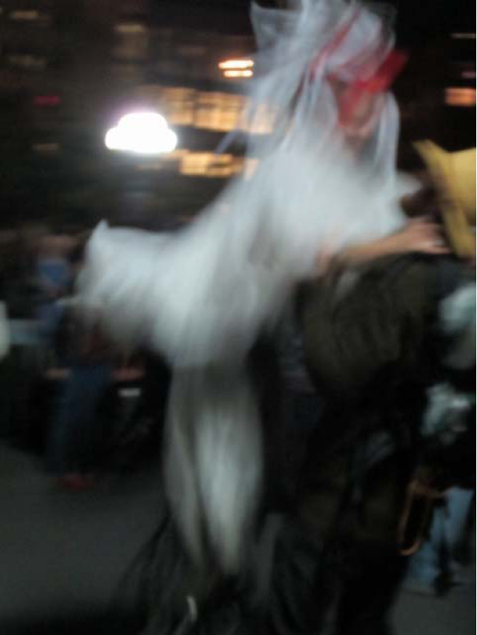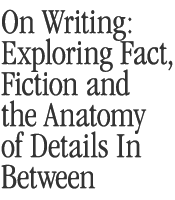


This is a sample class assignment completed by Ellice Amanna AC for Russ Rymer’s section of English 290 Crafting Creative Nonfiction in fall 2011. Students took photographs and then wrote about them. Eillice’s photo of a leaping dancer at Zuccotti Park in Manhattan was the inspiration for her blog entry.
All week she works the lines, wrapped in her signature white crinoline. [Those waiting to get into] Comic-Con at the Javits, the iPhone debut at Apple’s 5th Ave cube. The new act’s really coming together. Feeling the temperature drop, she frets about having to give up her diaphanous rags, dreams of those delicious white silk long johns in the window at REI. But tips have been spotty and they give half of everything to the movement. At first Zuccotti Park was just another performance venue, a place to pass Jake’s famous yellow hat. Now, Occupy is their home. They put in time at the People’s Library, join the morning circle for Radical Econ 101. Work days she paints her face white and black in the tradition, adds a smear of red for Marilyn Monroe. And it’s been a damn good week. The iPhone crowd was jazzed and generous. Comic-Con was a bust till an aging Wonder Woman who used to work the lines at the Sausalito Ferry back in the ’70s tosses a twenty in. Now she just wants to find Jake. She spots the hat first in the crush under the Welcome to the Paradigm Shift banner. Soon as he sees her coming, he unfurls them, a shimmering of white silk arms, legs straight out of her dreams, waves them wildly, triumphantly above the crowd. A shrieking shooting star, mad, mad, mad in love and trailing crinoline across Washington Square, she hits her mark and leaps.
The class concentrated on structure of long-form nonfiction, using photography as a way to inspire their writing and critique it. The blog allowed students to just let loose and express. All students submitted a blog entry each week, in which they took a photo (with any camera from cell phone to Nikon, whatever they had) and wrote a short paragraph to accompany it—the paragraph as closely observed by the writer as the image by the camera. Because the rest of the class was so tightly controlled, I tried to take a hands-off approach to the blog—it was a no penalty zone. And it became a place of remarkable expression, as Ellice's entry shows. We were reading a lot of material where prose and pictures conjoin—the work of writer James Agee and photographer Walker Evans, for instance, as well as the reports of World War II correspondent Lee Miller—but the students’ own work took the partnership in new and very personal directions.
One aspect of the class was to assert that creative writing, properly used, gets at truths—“facts”—that more cursory writing styles can't reach. Therefore, the creative nonfiction writer has an even more slavish obligation to serve fact and to observe accurately. This is where photography comes in: it roots their writing in what actually can be seen. It's the most objective art, and it's helpful for young writers to see how beauty (in photography) is derived from objective reality, not in opposition to it, that the key isn't manipulation, but observation. The tendency of young writers is to think that creativity is license and objectivity is a burden to be shucked. Photography teaches the writer that creativity is based on a devotion to perceiving reality. Ellice's photo of the leaping dancer is enigmatic, moody, and beautiful, but was manifestly real, not imagined, and her story achieves its emotional force from a close and faithful reporting of the facts. To this degree, creative nonfiction is first and foremost the art of perception, before interpretation can play its role.
















